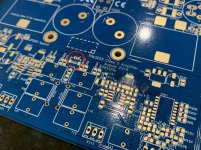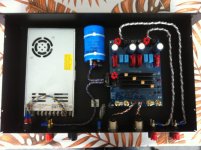So the Chinese boards did not have a built in provision for the frequency master/slave mode? Did you get the master/slave mode to work using those tiny magnet wires?
When you say not silent, is the noise only apparent when connected with two amps, but otherwise silent with one? Or is it inherent noise in the MW SMPS? My amp is absolutely silent (1 amp) with the low cost LED 48v 800w SMPS.
Here is a closeup of the little connector (X222) for the freq sync on my amp that you have, and hopefully will build in the future:
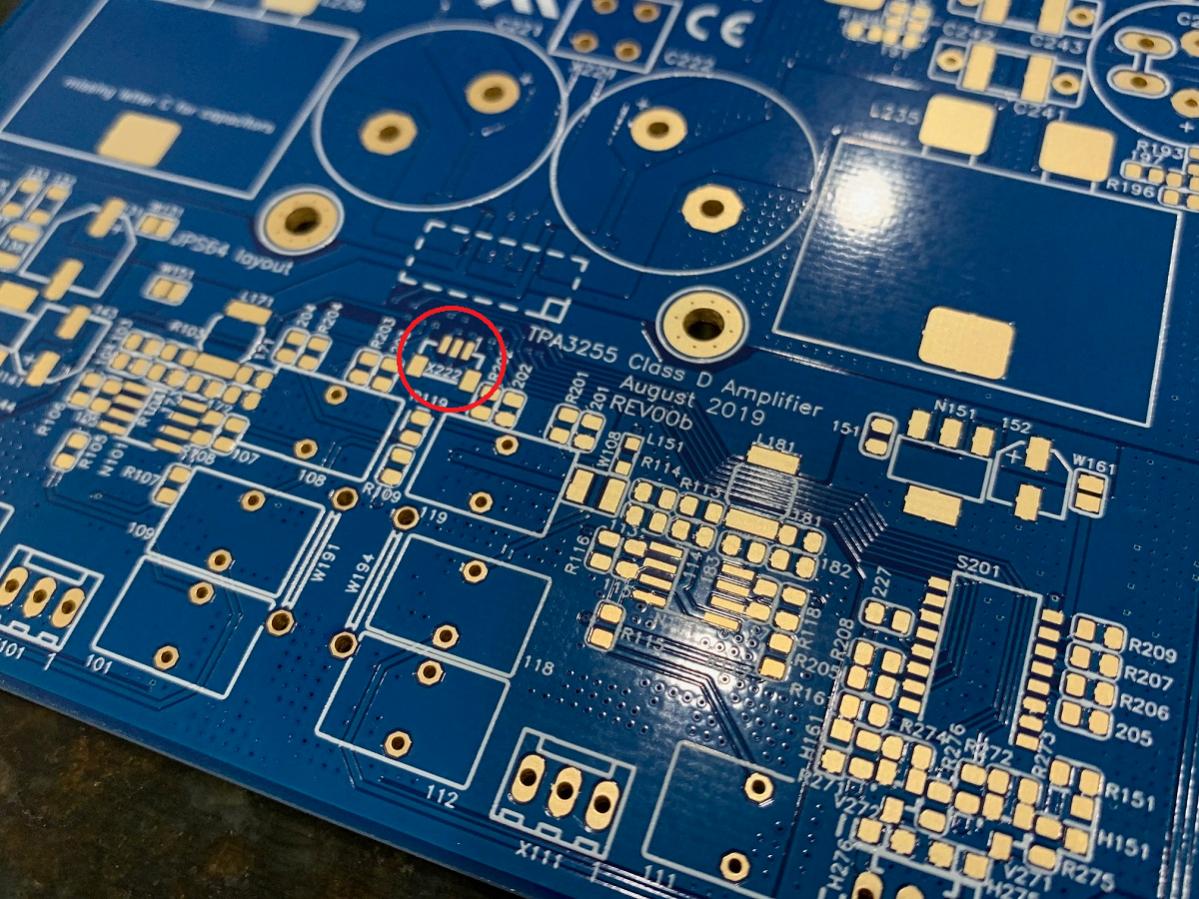
Uses a special connector.
When you say not silent, is the noise only apparent when connected with two amps, but otherwise silent with one? Or is it inherent noise in the MW SMPS? My amp is absolutely silent (1 amp) with the low cost LED 48v 800w SMPS.
Here is a closeup of the little connector (X222) for the freq sync on my amp that you have, and hopefully will build in the future:
Uses a special connector.
Attachments
Yes, it works on mine (the one above). I know. Voltwide and Dr Mord got it to work in theirs as well.
Although, I think I am not getting the ultimate lowest THD with mine, but I don’t have dominant 3rd order distortion like most other implementations. Here is 20w into 3.3ohms about 0.0021% THd. This amp has some terrific SNR and zero hum or hiss as you can see from FFT. It’s very quiet.
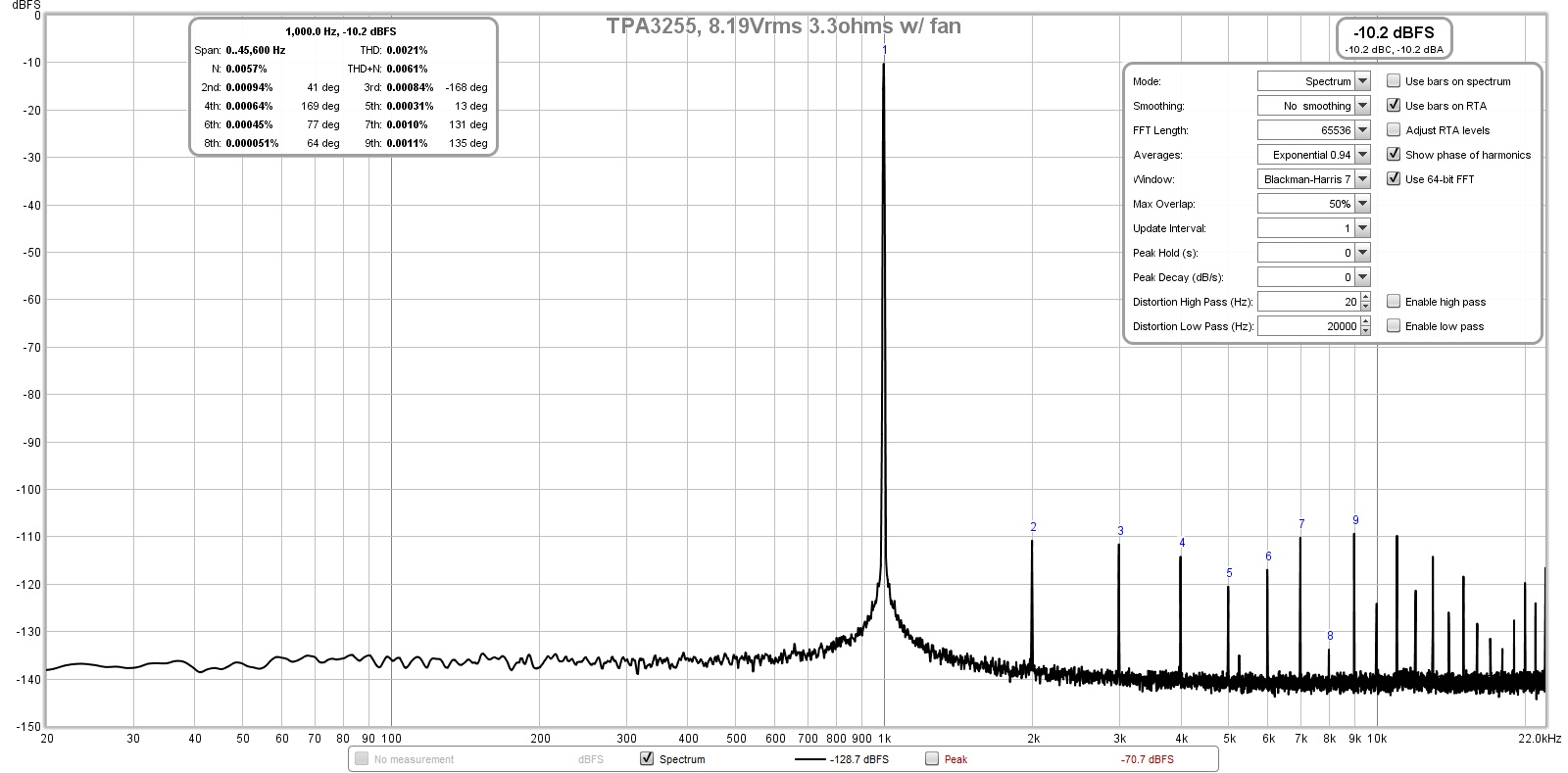
Although, I think I am not getting the ultimate lowest THD with mine, but I don’t have dominant 3rd order distortion like most other implementations. Here is 20w into 3.3ohms about 0.0021% THd. This amp has some terrific SNR and zero hum or hiss as you can see from FFT. It’s very quiet.
Last edited:
Obviously there is not one single optimal solution for PFFB.
You may do it like TI adding a high level ultra low distortion pre-amp and improve THD and output impedance for a certain amount.
Square response is improved as well to some extend.
Personally I choosed a different approach. I focus on best square response only, i.e. most linear frequency response considering further improvements of THD not worth the effort of implementing very low THD hi-level op-amp drivers.
This is a very simple patch consisting of a small feedback capacitor yielding optimal square response and linear frequency response nearly independent of the load.
You may do it like TI adding a high level ultra low distortion pre-amp and improve THD and output impedance for a certain amount.
Square response is improved as well to some extend.
Personally I choosed a different approach. I focus on best square response only, i.e. most linear frequency response considering further improvements of THD not worth the effort of implementing very low THD hi-level op-amp drivers.
This is a very simple patch consisting of a small feedback capacitor yielding optimal square response and linear frequency response nearly independent of the load.
So the Chinese boards did not have a built in provision for the frequency master/slave mode? Did you get the master/slave mode to work using those tiny magnet wires?
When you say not silent, is the noise only apparent when connected with two amps, but otherwise silent with one? Or is it inherent noise in the MW SMPS? My amp is absolutely silent (1 amp) with the low cost LED 48v 800w SMPS.
Here is a closeup of the little connector (X222) for the freq sync on my amp that you have, and hopefully will build in the future:
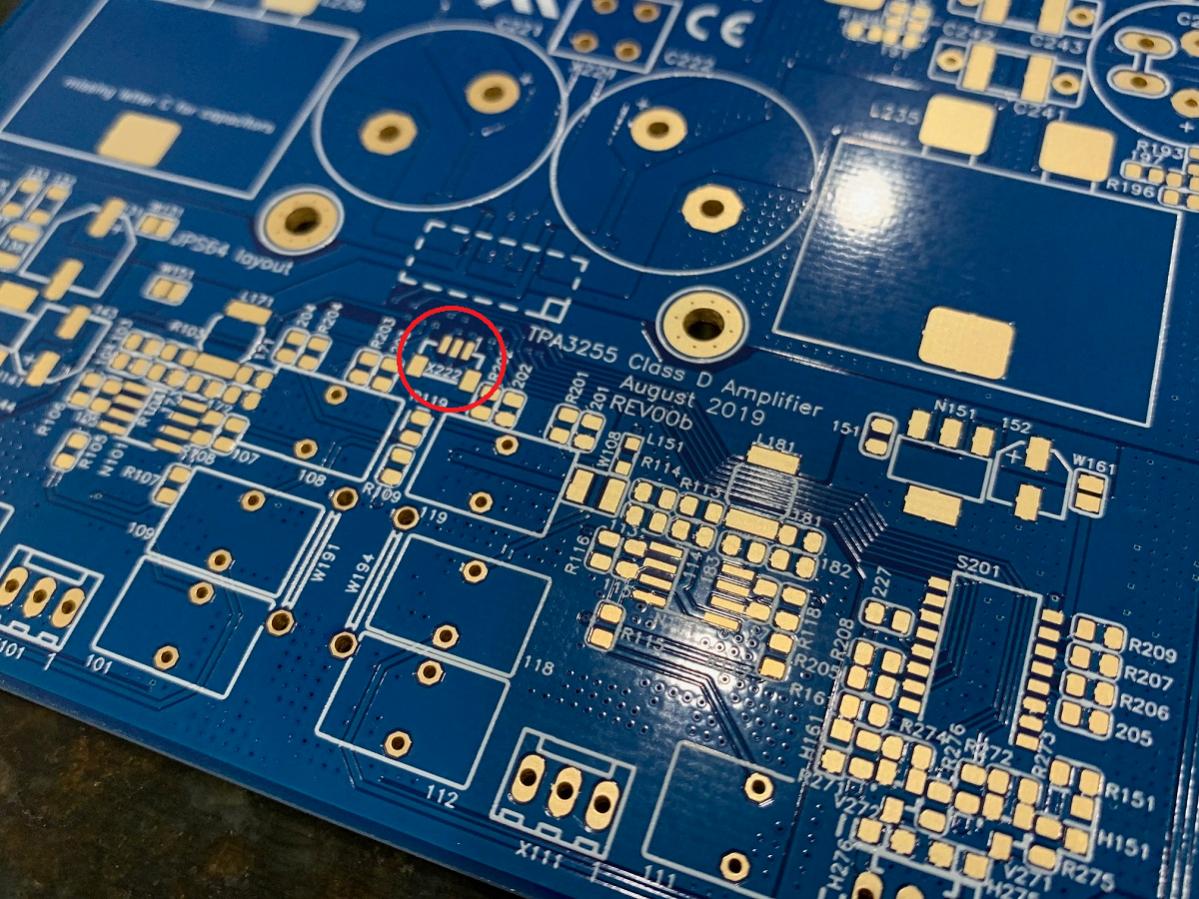
Uses a special connector.
Sorry for the late response.
Indeed, I got the sync to work using these tiny magnet wires (from a little motor taken from an RC-servo).
By itself, the board is very quiet, also both boards connected to the PS but not to an external source. However, the noise problem comes up when both boards are connected at their inputs with the common ground of the preceeding stage by RCA plugs, in my case a mini DSP. This is caused by ground differentials at the input, which exist in spite of the fact that both boards are grounded through the common suppy. There is an optimum spot for the supply ground connection, which may be different for your board.
It was a temporary setup for a show, so in the end I will drive the boards differentially and I expect the minute remaining noise to dissappear fully, but don't know yet. Just too buzy.
TPA3255EVM
Hello,
Finally bypassed TPA3255EVM op-amps via header J28 and grounded op-amps via J10 and J12 (+ and - to gnd)
Sound is different but to early to say something about it
My RME Adi-2 dac does not like this input and noisefloor raised resulting in more hiss in loudspeakers
Will listen to this setup for a few days and report
Enjoy...

ABSNimes, regarding differential input to the 3255EVM board, in stereo BTL mode, there are two slightly different approaches;
i) connect to the J10 and J12 headers (or all 4x RCA connectors, which I consider confusing) -
your audio signals will still be buffered by the NE5532 opamps, but remain fully differential.
ii) connect to pins 11,13,15,17 & 21-GND of the J28 header (as member mboxler suggested)
your audio signals will then bypass the opamps, and go to the TPA3255 simply via a DC blocking cap.
Which approach sounds better will likely depend on whether your particular source device benefits from a buffer in the chain. I suggest you try i) first.
Check your configuration - you want the board in 2 x BTL mode, with differential inputs;
J5(M1), J6(M2) should be in the "0" or "L" position.
J21, J7, J8 should be open.
J4, J19 should be in the "DIFF" position.
J26 should be in the "C" position.
J27 should be in the "D" position.
S1 should be in the "NORMAL" position.
If this works OK, and you want to then try ii)
I understand that the opamps should be grounded, since they will then be unused, and might otherwise generate some noise (or heat).
Hello,
Finally bypassed TPA3255EVM op-amps via header J28 and grounded op-amps via J10 and J12 (+ and - to gnd)
Sound is different but to early to say something about it
My RME Adi-2 dac does not like this input and noisefloor raised resulting in more hiss in loudspeakers
Will listen to this setup for a few days and report
Enjoy...
Yes, when you bypass the opamps you lose the in-built buffer, and your source device then might not play well with the TPA325x. In my case I have a DAC with transformer output stage, and for me the sound is very clean, but maybe just a little "thin". Forum member wolfram reports great results with this configuration, but I don't know what his source device is.Finally bypassed TPA3255EVM op-amps ...
Sound is different but to early to say something about it
I'm considering the purchase of a Soncoz LA-QXD1 DAC for a second system, and I would like to see if this DAC's differential outputs sound good when fed directly to a TPA325x amp.
Of course it's also possible to consider other forms of buffer, apart from opamp, such as jfet -
NECX and NESX Single-Ended to Balanced Converters
or tube -
Balancer
TPA3255EVM
Hello,
Concerning bypassed op-amps of TPA3255EVM
Grounded 4 RCA signals, J10 and J12 open and rerouted speaker cables inside amplifier enclosure
Speaker cables seemed to pick-up some noise
Noisefloor went down as before
Very clean and crisp sound
More detail and wider soundstage
To be continued
Enjoy...
Hello,
Concerning bypassed op-amps of TPA3255EVM
Grounded 4 RCA signals, J10 and J12 open and rerouted speaker cables inside amplifier enclosure
Speaker cables seemed to pick-up some noise
Noisefloor went down as before
Very clean and crisp sound
More detail and wider soundstage
To be continued
Enjoy...
sharpi31,
. . . Changing subjects, DizRotus lent me his Pono Player portable digital audio player, and I used his 3.5mm TRS-to-RCA balanced cables to directly connect the player in balanced output mode to the amp's differential inputs (jumpers switched from SE to DIF). The sound quality was very impressive and easily bested the combination of my Audio Research LS7 tube line stage with either my Sony ES DVD/SACD/CD player or the Pono Player in single-ended output mode. I still found my turntable feeding the Audio Research PH5 tube phono stage and LS7 line stage to be the best sounding source, but the gap between the Pono Player playing high res digital and my vinyl playback system was not that great.
The late Charles Hansen of Ayre Acoustics designed the Pono Player's playback circuitry and he really favored balanced circuits. The rich tone, articulation and huge soundstage that comes from the diminutive Pono Player feeding the TPA3255EVM's differential inputs really highlights what high-end performance is possible with the TPA3255.
Rich, you describe my experience exactly.
sharpi31,
Have you had a chance to wire the Lundahl input transformers directly to the TPA3255 inputs (bypassing the SMD electrolytic input caps and TI NE5532 op amps)?
Changing subjects, DizRotus lent me his Pono Player portable digital audio player, and I used his 3.5mm TRS-to-RCA balanced cables to directly connect the player in balanced output mode to the amp's differential inputs (jumpers switched from SE to DIF). The sound quality was very impressive and easily bested the combination of my Audio Research LS7 tube line stage with either my Sony ES DVD/SACD/CD player or the Pono Player in single-ended output mode. I still found my turntable feeding the Audio Research PH5 tube phono stage and LS7 line stage to be the best sounding source, but the gap between the Pono Player playing high res digital and my vinyl playback system was not that great.
The late Charles Hansen of Ayre Acoustics designed the Pono Player's playback circuitry and he really favored balanced circuits. The rich tone, articulation and huge soundstage that comes from the diminutive Pono Player feeding the TPA3255EVM's differential inputs really highlights what high-end performance is possible with the TPA3255.
In addition to the SQ qualities you mention, the convenience of easily selecting individual tracks from many albums more than makes up for the rituals associated with vinyl.
Hi,
No not realy
On powering up i get some hiss in loudspeakers for about 1 minute
Once caps are full amp is dead silent
Amp remains on 24/7
Enjoy
That's quite an optical illusion! The cap across the EVM terminals is hiding the fact that the negatives of the electrolytic and PS are connected to the black terminal and the positives to the red (?). The other non-polarized cap is parallel as well.
Nicely done!
Mike
Hi,
No not realy
On powering up i get some hiss in loudspeakers for about 1 minute
Once caps are full amp is dead silent
Amp remains on 24/7
Enjoy
My experience is similar. There is no hiss from the efficient Klipsch speakers. Since I too leave it powered 24/7, I don’t specifically recall if there was any hiss at startup, but I don’t believe there was.
Hello,
Bypassing op-amps on my TPA3255EVM was a succes
Installed final wiring and put cover back on
Difficult to put in words
I like what i am hearing
I can easily say the best free tweak i ever did
Enjoy...
Hello again,
Still enjoying my TPA3255EVM but also looking for possible further improvements
Went through 90 pages but did not find alot of information about the output filter stage concerning less components in signal path and/or optimizing for 8ohm load
Any advice is appreciated...
- Home
- Amplifiers
- Class D
- TI TPA3255EVM
